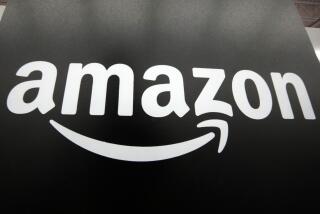Amazon’s seven new Kindles reflect rapidly growing tablet market
Amazon.com Inc.’s seven new versions of its Kindle offer consumers more choices in the rapidly expanding tablet market.
But for Hollywood, the news is decidedly mixed.
At an invitation-only Santa Monica event Thursday, the online retailer introduced its new Kindle Paperwhite e-reader, which Chief Executive Jeff Bezos described as “thinner than a magazine and lighter than a paperback,” and a Kindle Fire HD tablet, which boasts features such as X-ray for Movies, an application allowing the viewer to look up information about any film with a tap of the finger.
Amazon’s prodigious device lineup — with tablets and e-readers ranging from $69 to $599 — suggests a direct challenge to market leader Apple Inc. But these gadgets advance a different goal: to broaden access to Amazon’s growing library of movies and television shows.
“We want to make money when people use our devices, not when they buy our devices,” Bezos told the crowd of about 250.
The rabbit-like proliferation of these devices has spurred media viewing, as consumers increasingly use go-anywhere screens in place of a second TV in the home. Although on the surface the explosion of new screens would suggest an opportunity for film and television studios, the reality is more complex.
Although millions of consumers have paid $830 for a shiny new Apple iPad or $199 for Google Inc.’s rival Nexus 7 tablet or Barnes & Noble Inc.’s Nook, they’re still looking for the cheapest way to watch movies and TV shows on these devices, media analysts say. Consumers have been moving away from purchases in favor of inexpensive alternatives such as movie rentals or online subscription streaming services such as Netflix, which return less money to the studios.
“As these new portable technologies exploded in the last two years, this has just accelerated the trend,” said Tom Adams, principal media analyst for researcher IHS Screen Digest, noting that purchasing has been declining since 2007.
This shift away from ownership is reflected in the most recent report of consumer spending on home entertainment. Purchases of DVDs, Blu-ray discs and digital titles in the first six months of 2012 declined 2% from the first half of 2011. At the same time, spending on subscription streaming has risen exponentially, to $1.1 billion in the first half from $208.2 million a year earlier, according to a report from the Digital Entertainment Group.
Tablets are helping drive changes in how media is viewed in the home.
Some 126.6 million tablets are expected to be shipped worldwide this year, a leap of 56% from 2011, according to researcher IHS iSuppli. Apple continues to dominate the tablet market, which it ignited with the 2010 introduction of the iPad. The Cupertino, Calif., technology giant has sold some 84 million tablets and is rumored to be developing an iPad Mini to compete with rival gadgets with lower price tags. Other entrants — from Amazon’s Kindle Fire to the Galaxy Tab from Samsung to other tablets powered by Google’s Android operating system — are expanding the market.
“We’re going to see rapidly declining prices and continuing adoption of tablets by Americans,” said Bill Niemeyer, a senior analyst at the Diffusion Group, a consulting and research firm. “And they’re not just buying one. We’re talking about multiple tablets in a household. Instead of buying a small TV for the bedroom, they’re using a tablet. The big-screen TV in the living room is not going away, but the second and third TVs — those are going to increasingly be replaced by tablets.”
That’s both an opportunity and a challenge for the television networks, Niemeyer said, depending on whether they’re able to take advantage of the surging tablet market.
Time Warner has successfully capitalized on the tablet mania with its HBO Go application, which allows subscribers to the cable channel to watch shows on their portable device, Niemeyer said. Walt Disney Co. struck a deal with Comcast Corp. in June that makes live streams of Disney Channel, Disney XD and Disney Junior shows available to subscribers through an iPad application.
Netflix similarly is thriving on the tablets. Although most of the 24 million subscribers to its U.S. streaming service still prefer to watch movies and TV shows on their TVs via Internet-connected game consoles, viewing on tablets is growing rapidly, a spokesman said.
Several film studio executives privately expressed the hope that tablets will one day lead consumers to build digital movie libraries, in the same way that portable devices have caused people to amass virtual bookshelves of music and books.
One television executive, speaking on background because of the sensitivity of the issue, said he doesn’t view tablets as cannibalizing television audiences. Indeed, shows discovered through online streaming services can build audiences for shows. The biggest worry for networks is the inability to measure viewership on mobile devices, making it impossible to quantify these audiences for advertisers, whose commercials underwrite much of the cost of creating expensive television content.
Amazon recognizes the power of its portable, go-anywhere media tablets to augment the popularity of its Amazon Prime service, which enables subscribers who pay a $79 annual fee to stream thousands of movies and television shows. This week, Amazon struck a multiyear deal with Epix to add titles from Paramount, Lionsgate and MGM to its Instant Video service.
Amazon’s seven new devices are a cheaper Kindle e-reader for $69; two versions of its new front-lighted Paperwhite e-reader; an upgraded Kindle Fire tablet for $159; and three HD Kindle Fires: a 7-inch Wi-Fi version, an 8.9-inch Wi-Fi version and an 8.9-inch 4G model. Prices for these HD models range from $199 to $599.
Paperwhite, which comes in $119 and $179 versions, features a higher resolution, up to eight weeks of battery life and a slimmer design.
The Kindle Fire HD family features 25% less glare, dual antennas for faster Wi-Fi and a front-facing HD camera.
The devices have staggered release dates through Nov. 20 in anticipation of the holiday season.






